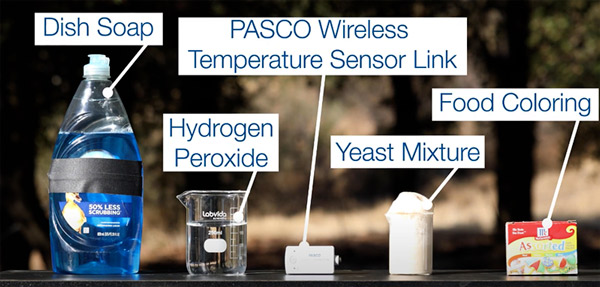Halloween Science: Oozing Pumpkin Experiment
This Halloween, give your jack o’lanterns new life with this foam-tastic demonstration of exothermic reactions!
The Oozing Pumpkin experiment puts a Halloween twist on a classic chemistry demonstration. It’s safe, simple, and the perfect way to get students thinking about chemical reactions and reaction rates.
How the Oozing Pumpkin Experiment Works
Hydrogen peroxide (H2O2) rapidly decomposes in the presence of catalase, an enzyme found in most living organisms. Under normal conditions, the products of this decomposition reaction — water and oxygen — behave about as blandly as expected. The oxygen gas quickly escapes, rising and popping in tiny bubbles. But adding a bit of dish soap to the hydrogen peroxide increases surface tension, which traps the oxygen gas in large bubbles that make up the foam.
The decomposition reaction of hydrogen peroxide is represented by:
H2O2 → 2H2O2 + O2
The decomposition of hydrogen peroxide in the presence of catalase is thought to occur in two stages. These stages are quite complex, and it may be better to discuss an alternative, yet similarly exothermic reaction with students.
Here, potassium iodide is used as a catalyst in the decomposition of hydrogen peroxide:
H2O2 + I- → H2O + IO-
H2O2 +IO- → H2O + O2 + I-
Materials

- Wireless Temperature Sensor Link
- 12% Hydrogen Peroxide (Available from most beauty supply stores as “40 Volume”)
- Baker’s Yeast (1 packet)
- Warm Water
- Dish Soap or Laundry Detergent
- Food Dye (optional, but recommended)
Before the Demonstration
This chemical reaction is safe for students of all ages, but it is messy. If you do not teach in a lab environment, you may want to cover surfaces within a foot of the reaction or perform the demonstration outside.
Procedure
- Prepare 45 mL of warm water and place it in a small cup or beaker.
- Lightly stir 1 packet of baker’s yeast into the warm water and let it sit for ten minutes.
- Pour 200 mL of 12% hydrogen peroxide into a 250-mL beaker. Note: A higher concentration of hydrogen peroxide will increase the rate of the reaction.
- Add a squirt of dish soap and a few drops of food dye to the beaker of hydrogen peroxide.
- Pair the Wireless Temperature Sensor Link to your device using either SPARKvue or PASCO Capstone. Create a graph and digits display to project to students during the reaction.
- Place the pumpkin on a raised surface, so that it is easily viewable.
- Carefully place the beaker containing the hydrogen peroxide mixture in the pumpkin.
- Place the temperature probe in the beaker, while keeping the Wireless Temperature Sensor Link away from the pumpkin.
- Begin data collection.
- Quickly pour the yeast mixture into the beaker inside the pumpkin and place the lid on top.
Discussion and Analysis
Depending on the grade level you teach, you may want to connect this demonstration to any number of concepts, including catalysts and reaction rates, endothermic and exothermic reactions, or decomposition reactions.
Some possible questions to pose to students about the demonstration include:
- Do you think the rate of the reaction would change if we cooled the reactants beforehand? How so?
- What are some ways we could increase the rate of the reaction?
- Research one way to increase the amount of foam produced. (Hint: refer to note in the procedure for the answer.)

